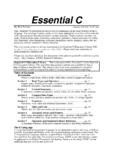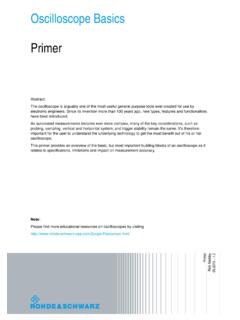Transcription of A Study on the basics of Quantum Computing - arXiv
1 A Study on the basics of Quantum Computing Prashant Department d Informatique et de recherch operationnelle, Universite de Montreal, Montreal. Canada. ~prashant/ Abstract Quantum theory is one of the most successful theories that have influenced the course of scientific progress during the twentieth century. It has presented a new line of scientific thought, predicted entirely inconceivable situations and influenced several domains of modern technologies.
2 There are many different ways for expressing laws of science in general and laws of physics in particular. Similar to physical laws of nature, information can also be expressed in different ways. The fact that information can be expressed in different ways without losing its essential nature, leads for the possibility of the automatic manipulation of information. All ways of expressing information use physical system, spoken words are conveyed by air pressure fluctuations: No information without physical representation.
3 The fact that information is insensitive to exactly how it is expressed and can be freely translated from one form to another, makes it an obvious candidate for fundamentally important role in physics, like interaction, energy, momentum and other such abstractors. This is a project report on the general attributes of Quantum Computing and Information Processing from a layman s point of view. Keywords: computation, EPR, Quantum mechanics, superposition, unitary transformation, decoherence.
4 2 TABLE OF CONTENTS Abstract Chapter 1: Introduction Chapter 2: Literature Survey A Brief History of Quantum Computing Limitations of Classical Computers and birth of art of Quantum Computing Public key Cryptography and Classical factoring of big integers. Quantum Factoring Searching of an item with desired property. Simulation of Quantum system by classical computer. Quantum Computing : A whole new concept in Parallelism Quantum Superposition and Quantum Interference: Conceptual visualization of Quantum Computer.
5 Quantum Entanglement Bertleman s Socks EPR situation, Hidden Variables and Bell Theorem An EPR situation Bell Inequalities. Quantum Teleportation and Quantum Theory of Information Thermodynamics of Quantum Computation Experimental Realization of Quantum Computer Heteropolymers Ion Traps Quantum Electrodynamics Cavity Nuclear Magnetic Resonance Quantum Dots Josephson Junctions The Kane Computer Topological Quantum Computer Future Directions of Quantum Computing 3 Chapter 3.
6 A New outlook to the Principle of Linear Superposition Modification of Wave function as a requirement of Quantum Teleportation Introduction of EPR correlation term in Expansion Theorem Suitability of Quantum bits for Quantum Computation An alternative interpretation of Quantum No Cloning Theorem. Chapter 4: Experimental realization of Quantum Computers Materials of Low dimensionality- Quantum Dot a promising candidate. Need for Modified Coulomb Potential and its analysis Analysis of Quantum Dots using Modified Coulomb Potential.
7 Study of Quantum Wires using Modified Coulomb Potential Visit to Nano Technology Lab in Barkatullah University, Bhopal Chapter 5: Future Directions of Research Explanation of Measurement Problem by Symmetry breaking EPR Correlation: Interacting Hamiltonian Vs Non linear wave function Possibility of third paradigm in Quantum Mechanics Conclusion and Future Scope References 4 List of Figures: Fig 1: Showing number of dopant impurities involved in logic in bipolar transistors with year.
8 Fig 2: Beam splitting of light Fig3: Example to show wave particle duality of light Fig 4: EPR paradox description using He atom Fig 5: Graphical description of the EPR situation Fig 6: Quantum Dots Fig 7: Quantum Teleportation using Entanglement Fig 8: The graphical representation of the Modified Coulomb potential Fig 9: Plot of Wave Function Vs. distance in a Quantum Dot Fig 10: Quantum Wire as a 1-D system Fig 11: Quantum Dots as seen from an Atomic Force Microscope Fig 12: The tip of the Scanning Tunneling Microscope Fig 13: AFM Plots of Quantum Dots prepared in laboratory.
9 5 CHAPTER 1 INTRODUCTION With the development of science and technology, leading to the advancement of civilization, new ways were discovered exploiting various physical resources such as materials, forces and energies. The history of computer development represents the culmination of years of technological advancements beginning with the early ideas of Charles Babbage and eventual creation of the first computer by German engineer Konard Zeise in 1941.
10 The whole process involved a sequence of changes from one type of physical realization to another from gears to relays to valves to transistors to integrated circuits to chip and so on. Surprisingly however, the high speed modern computer is fundamentally no different from its gargantuan 30 ton ancestors which were equipped with some 18000 vacuum tubes and 500 miles of wiring. Although computers have become more compact and considerably faster in performing their task, the task remains the same: to manipulate and interpret an encoding of binary bits into a useful computational result.
![arXiv:0706.3639v1 [cs.AI] 25 Jun 2007](/cache/preview/4/1/3/9/3/1/4/b/thumb-4139314b93ef86b7b4c2d05ebcc88e46.jpg)

![arXiv:1301.3781v3 [cs.CL] 7 Sep 2013](/cache/preview/4/d/5/0/4/3/4/0/thumb-4d504340120163c0bdf3f4678d8d217f.jpg)
![@google.com arXiv:1609.03499v2 [cs.SD] 19 Sep 2016](/cache/preview/c/3/4/9/4/6/9/b/thumb-c349469b499107d21e221f2ac908f8b2.jpg)








